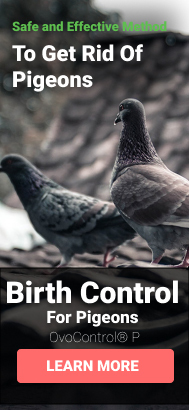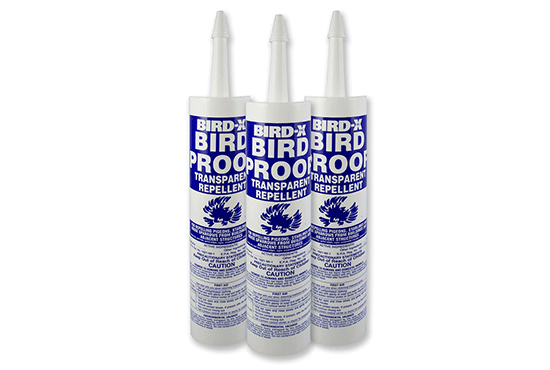Pigeon Repellent Options – Spikes, Gels, Optical Gel, Fogs and Vapors
Written by Erick Wolf
If reading this page, it means that you are probably in search of the best solution to keep pigeons away from a particular space or area.
There are many ways to get rid of pigeons and some solutions are more effective than others.
Efficacy is most often a function of the site and circumstances.
Pigeon repellents are one of the most economical and rapid solutions available for pigeon problems and mostly the installation is quite easy.
Let’s dive in...
The most common pigeon repellents include,
1. Spikes
2. Gels and Pastes
3. Optical Gels
4. Ultrasound Devices
5. Plastic Owls
6. Reflective Discs
7. Fogs and Vapors
In this article, we will describe each repellent in detail and outline the advantages, disadvantages, effectiveness, and areas they are best suited for. The table below provides a summary of all the pigeon repellents which will help you quickly compare the solutions.
Comparison Table of Pigeon Repellent Options
| Method/Product | Best Used For | Advantages | Disadvantages |
| Repellents | |||
| Spikes | Rails, perching areas | Inexpensive; can be highly effective under the right set of conditions; easy installation | In best case, will only move birds to the next best location |
| Gels and pastes | Perching areas | Inexpensive | Can kill smaller birds; requires consistent reapplication |
| Optical Gel | Perching and loafing areas | Small and inexpensive; easy to install | Not necessarily appropriate for larger areas. Intensive cleaning required. |
| Sonic and ultrasonic emitters | Aural harassment | Can be used in larger areas where exclusion is not practical | Birds acclimate to the sounds |
| Plastic Owls | Visual harassment | Can be effective short term | Birds acclimate to effigies |
| Reflective Discs | Visual harassment | Cheap and Easy to install | Can be easily demaged or blown away by the wind |
| Fogs and vapors | Large indoor areas | Ideal for large volume structures | Inconsistent action |
Do Pigeon Repellents Work?
The short answer is, “yes and no”. Some of the repellents are effective, some of them less so, as birds tend to acclimate and eventually ignore the device. Many repellents will often work in certain areas better than the others.
The only thing certain is that pigeon repellents do not solve the pigeon dilemma. The repellents simply move the birds to the next best location on your structure or to an adjacent structure.
Before deciding to invest in any pigeon repellent, try to understand what exactly attracts pigeons in your property, which will lead you to more logical choices.
What Are the Types of Pigeon Repellents?
In this section, we will review each available pigeon repellent in more detail.
1. Spikes
Overview:
Spikes are a common and inexpensive solution for physically excluding pigeons. Most often manufactured in strips, they work on the premise that pigeons cannot land on the pointed ends of the spikes. Spikes come in different shapes and materials - stainless steel or plastic, blunt or pointed, so you can choose based on your requirements.
Effectiveness:
To use the spikes effectively you must place them in strategic areas where you normally see the pigeons land and perch. With the use of almost invisible clear plastic spikes, you can secure your target areas.
The downside is that birds will relocate, instead of leaving the area. While the spike strategy can represent an effective solution, on a large campus or hotel they won’t be effective enough.
You can use the spikes to keep the birds away from narrow perching areas, however, in areas like apartment buildings, they will simply move to the next best area without spikes. If your goal is to keep them away from a single railing, spikes can be a good solution, but if you are responsible for the entire building with more than 100 railings, you might need to consider another option.
Recommended Product:
The price may vary depending on the material and length of the product, but the average price for a 10 feet spike is $20. You can check out Bird-X spikes on Amazon.
2. Gels and Pastes
Overview:
A gel is exactly what it sounds like, sticky transparent goo. It is normally applied to ledges or other areas with a caulking gun where pigeons are unwanted. Some of the gels include an active ingredient, often essential oils, which the pigeons find offensive.
Pigeons will avoid landing on treated areas since their feet get stuck in the gel and can take them hours to preen off the goo.
Effectiveness:
These products represent a short-acting solution since the gel quickly dries or gets covered with dust or debris, becomes ineffective, and requires cleanup and reapplication. Unfortunately, smaller birds can also get stuck in the gel, sometimes permanently.
Recommended Product:
3 packs of BirdX pigeon gel cost about $37, however, it is necessary to carefully consider where to apply the gel.
3. Optical Gels
Overview:
Optical Gel is a non-toxic, low-profile bird repellent that provides a versatile solution to problems where more traditional bird control methods may not be applicable. It is a multisensory repellent gel that comes in pre-filled dishes.
Optical Gel deters pigeons by triggering multiple sensory responses. According to the manufacturer, the material emits UV light to make it appear as a flame to approaching birds.
Effectiveness: Optical Gel contains citronella and peppermint oil, which are mild and pleasant to humans, but offensive to birds. For the most stubborn birds, Optical Gel is sticky and will make any perch unpleasant should they choose to touch or stand on the product. The gel dishes are small and are easy to install.
Recommended Product: Optical gel is offered by a California company, Bird Barrier. The price per 24(PK) is $95.
4. Ultrasonic Devices
Overview:
An ultrasonic device represents another harmless solution for pigeon control. Triple Scan technology claims to recognize birds at a distance and make them go away with sound waves. The device itself has a set of modes that you can configure depending on the season.
Pigeons can hear in the same audible range that people do. Therefore, if you are unable to hear the sounds from an ultrasonic device, the birds cannot hear it either.
Effectiveness:
Ultrasonic systems can be used in a wide variety of locations without causing human interference making them an ideal choice for areas where noise-related scaring is not an option. The exception to this rule may be where women and young children are concerned. With age, the human ear loses the ability to hear ultrasound but, in some women, and particularly in the young, ultrasound falls within hearing ranges and can cause considerable discomfort and headaches. This may have the effect of restricting the use of ultrasonic pigeon and bird hazers when used for pigeon and gull control in urban areas and on industrial sites.
Also, if you are not using electricity the ultrasonic device must be charged frequently.
Recommended Product:
The average price for ultrasonic repellents is $35. Check out the ultrasonic repellent by Bird-X
5. Plastic Owls
Overview:
Plastic owls are mostly used to scare birds from gardens, farms, and small areas like balconies.
Effectiveness:
Unfortunately, while they may provide some temporary relief, effigies like a plastic owl have little or no long-term effect on a pigeon’s behavior. The same holds true for other effigies that are recommended for pigeons.
Recommended Product:
You can find plastic owls and scarecrows on Amazon, the average price is about 20 dollars.
6. Reflective Discs
Overview:
It is an aesthetic and harmless bird repeller that you can use anywhere. The discs can hang on windows, near the garden, car, and pool. The set usually includes reflectors with three or more discs. The discs do not require much space and do not spoil the exterior of the house.
Effectiveness:
This solution helps to scare away the birds without harming them. The only disadvantage is they can be damaged by the wind. Mirror discs reflect the sunlight and blind pigeons, helping to keep them away from the area. The product is effective for small areas and you can use it to protect your house or pool from pigeon droppings.
Recommended Product:
The average cost for 16 discs is 9 dollars. The discs can have various shapes, however most of them are round. Check out a pigeon disc option here!
7. Fogs and Vapors (Methyl Anthranilate)
Overview:
Fogs and vapors are normally better suited for larger facilities or structures. The most common fog product is based on methyl anthranilate or MA. Methyl anthranilate is widely used in the flavoring and cosmetics industry to give grape scent and flavor and has been used extensively in flavoring foods (e.g., candy, chewing gum, soft drinks, alcoholic drinks, and drugs). Marketed under a variety of trade names, the product has a strong odor of grape juice which birds can be sensitive to and want to avoid. MA also has an application as a bird repellent for crop protection.
Effectiveness:
For birds, for the MA to be effective, it must be airborne in a fog. Normally this is achieved with a hazer or fogger which suspends the oil-based solution into small particles that are lighter than air. The foggers are set on timers to release the correct amounts at regular intervals. Keeping constant pressure on target birds increases the success rate.
MA works by irritating the bird’s sense of smell and taste and they will tend to avoid areas where the product is suspended in the air. The challenge is keeping the MA fog in the area where the birds are not desired.
Recommended Product:
Bird Barrier of America offers a formulation of methyl anthranilate.
Why Care About Pigeons?
Pigeons love cities and other environments with available food, water, and quality nesting habitat to raise young. Pigeons are most comfortable around people and you will not find them in the wild. That is not where they thrive.
But the ever-growing pigeon flocks in cities can become a serious problem when their growth spills out into both commercial and residential establishments. The constant cooing of pigeons in residential sites may be a source of irritation, but it is their droppings that pose potential health and safety risks.
At commercial sites, their droppings end up on handrails, chairs, benches, and doorknobs and not only does the pigeon poop represent a slip and fall hazard, it turns into a health hazard when it is tracked inside of homes, businesses and/or hospitals. At residential sites, the pigeons might find your balcony to be the perfect place to hang out and maybe even to build their nest
Pigeon droppings contain corrosive matter strong enough to corrode metal -- the collapse of the bridge in Minneapolis in 2007 is an example of what can happen when pigeon droppings are ignored -- over time, the build-up can have devastating consequences. Pigeon droppings combined with a design flaw caused a tragic event.
SUMMARY
In summary, repellents can be effective in low to moderate “pigeon pressure” circumstances. Outlandish claims of efficacy should be viewed skeptically. In all cases, their use simply keeps the birds from the treated areas but does nothing to reduce the population. To achieve this objective the site must consider pigeon culling or contraception.
Learn more about pigeon control alternatives:
- Pigeon Culling Methods: Poisoning, Shooting, Traps and Raptors
- Reducing Pigeon Reproduction: A Long-Term Solution for Pigeon Control
- Physical Exclusion of Pigeons – Spikes, Wires, Nets and Slides
- Pigeon Deterrents - Effigies, Sonic Emitters, Propane cannon
- Bird Netting: Everything you Should Know











